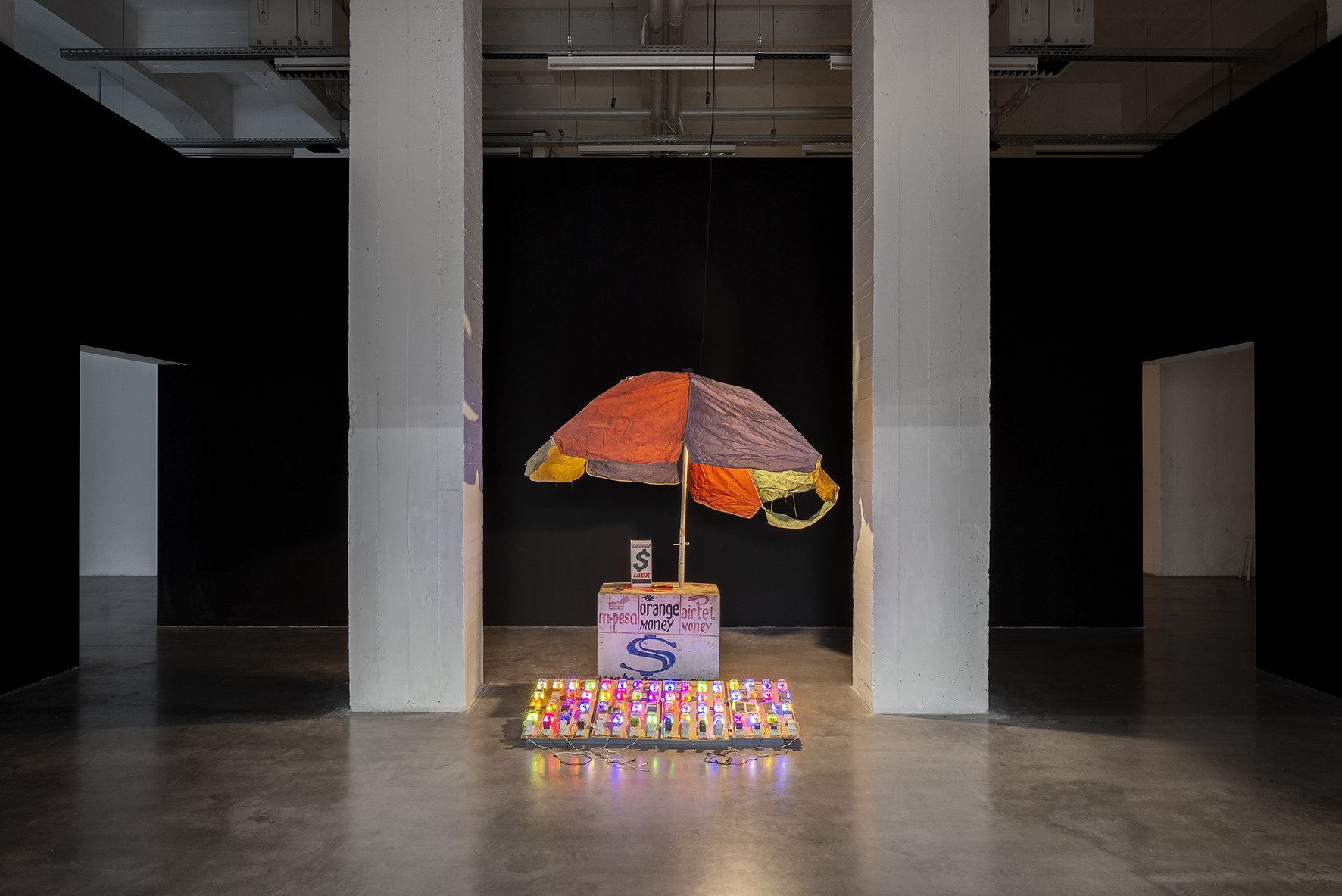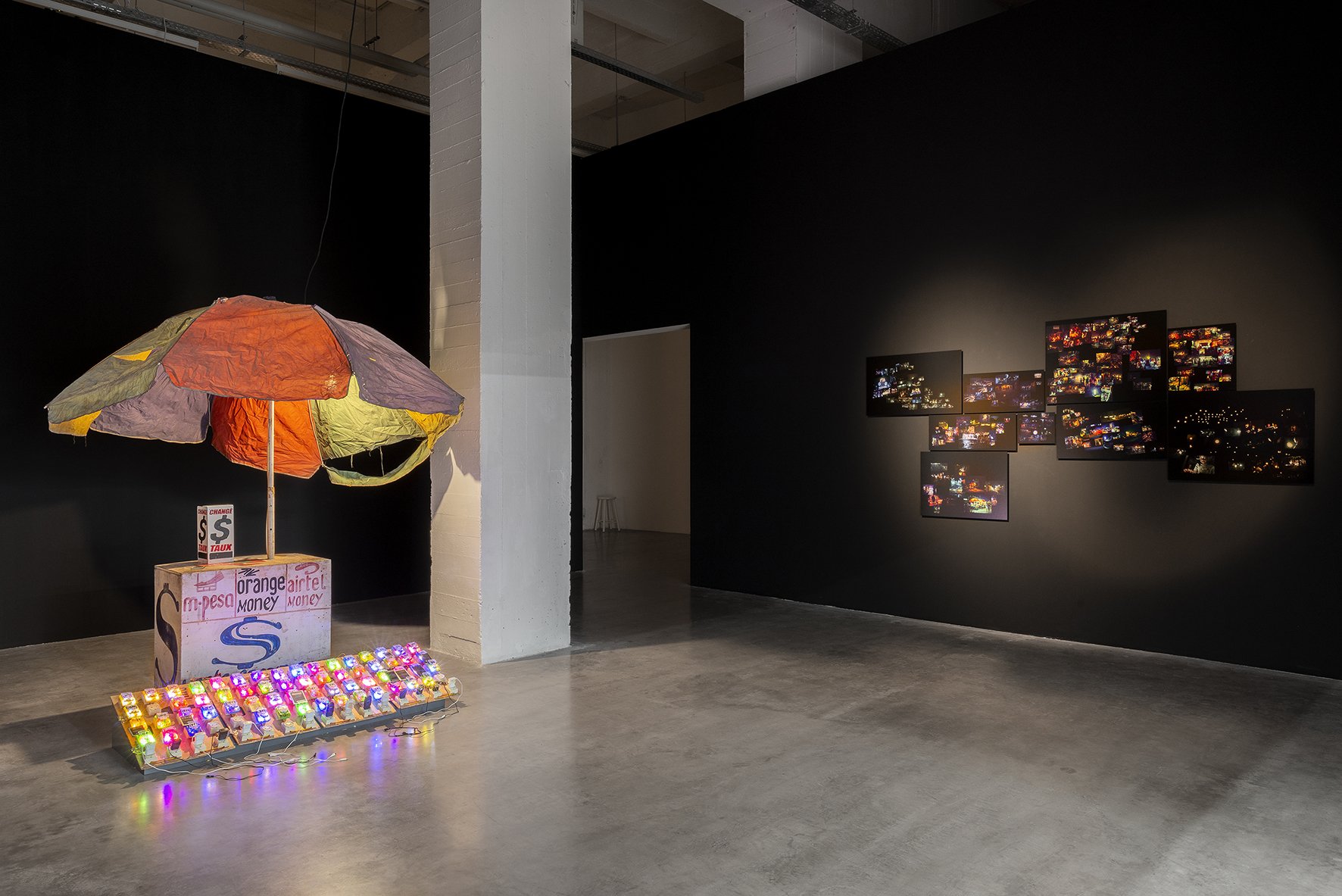
Gideon Appah and Nelson Makengo
Gideon Appah, The dancers, 2022, Oil and acrylic on canvas, 72 1/8 x 88 1/4 inches
A conversation with contemporary African artists Gideon Appah and Nelson Makengo about their work, recent exhibitions, and inspirations.
Interview by Camilla Boemio
Gideon Appah
Your new solo exhibition, A Nubian Landscape, reflects themes and narratives that you have been exploring for the last few years. Do these paintings include imagery from the past, or are they a contemporary vision of this geographical area?
The works are imaginative spaces I created to place the figures. They’re not entirely based on existing images, but I wanted to bring in a few things like mountains, stars, skies, water, land, and lawns. Those are small elements brought into the works, but for the most part, they are reliant on my imagination.
Gideon Appah
The colors you used are profoundly magical; the blues and deep reds create this melancholy state and an intense vision. How did you choose them?
The colors came about by choice. I came upon a tint of blue that I thought was very different from what I had seen or used before. To make the work very original, I thought using this blue for the sky was okay, so I painted in very flat blue tones and shades of bright blue. Then, it moved on from there. I worked with blue and started working into reds in the landscape with the skies and water in my way, and of course, I’m using different shades of red in oils, so the red and blue are actually by choice.
Did you tap into memories for this body of work?
I wanted to visit Egypt and South Sudan, but because of political unrest, I couldn’t go there, so they are not memories I’m looking at. I am very interested in figures the forms and putting them in a different environment.
Gideon Appah, The gathering, 2022, oil and acrylic on canvas, 72 1/8 x 88 1/4 inches
Gideon Appah, Double green through red landscape, 2022, oil on canvas, 72 1/8 x 88 1/4 inches
Gideon Appah, Triennale Milano (installation view), Courtesy Gallery 1957
Nelson Makengo
Tell me about your background — what experiences had the strongest influence on your artistic development?
I got interested in computer science back when I was 15. At that time, it was a luxury for someone to touch even a computer keyboard. As I had access to my mom's computer and a digital camera from my dad, I was very quickly interested in historical documentaries that I would watch on TV or, more often, on my mom's computer. That turned out to be so fascinating to me. Then I wondered: "how does it work to transmit all these emotions from archives, photos, papers, and texts?" My answer to that question led me to an early editing practice, grabbing as many of my family members' photos as possible with my digital camera and trying to tell a story through them. Later on, the same activity became one of my favorite hobbies. Sometimes I would lock myself away for days trying to find the best way to tell a story through the language of editing. I got a real kick out of sharing my exciting and motivating experiences with my family's amazement. Without realizing it, it has already impacted my view on how I can look at others through images.
Later, I was inspired by Russian and Soviet cinema, Avant-garde cinema. I find a style in the work of Dziga Vertov or Eisenstein close to the literature of the Congolese authors I admire, like Fiston Mwanza Mujila's Tram 83. Literature that depicts the contemporary world that is not only literature but rather physical literature. You can feel the body moving, this body that resembles us, because in this cinema, this literature, beyond the stories, we go through a very remarkable experience of the language.
Nelson Makengo
Nelson Makengo, Nuit Debout/Up at Night, 2019, video screenshot, WIELS
Can you give readers an introduction to Nuit Debout/Up At Night, your award-winning documentary and installation?
Indeed, Kinshasa does not fall asleep; it is in perpetual resilience, trying to provide what is necessary for the providence of a few night owls who are not afraid to brave the darkness in search of something to survive in this feverish hegemony of the night. In a society where religious faith is a way of distracting oneself from life's difficulties, Nuit Debout bears witness to the courage of the men and women who resist the absurdity in which my country has always lived. It addresses issues at the heart of the daily lives of the Congolese people and touches on pressing political and social issues.
I tell the story of this unfinished city nestling in the demographic effervescence of the 21st century, where the construction of the state and national identity remains a kind of reverie, a utopia. But this utopia of fierce modernism remains engraved in our minds. A debt is a debt, but we wait. In the meantime, the population is reinventing the question of individual lighting to counter the darkness, the obscurity, and the personal and collective shadows.
It is in this perspective, where young people my age have stopped dreaming because you have to survive from day to day, that I decided to place my camera and exercise my gaze through this quest for light. What about the beauty in all of this? It’s about self-illumination. Whatever the cost.
Nelson Makengo, Nuit Debout/Up at Night, 2019, installation view, WIELS
Nelson Makengo, Nuit Debout/Up at Night, 2019, installation view, WIELS
What inspired you to develop this particular work?
My encounter with Paris, “Ville lumière”! Returning from Paris in 2016, on the plane, after my first time in Europe, I was struck by night over Africa and particularly over Congo, where I live. Even when you fly over Kinshasa, an overcrowded metropolis, you are in a darkness that creates a unique atmosphere. From this aerial view, the absence of luminous areas is unsettling, both exciting and disturbing.
In Europe, where I had spent two months, I had been in touch with the Nuit debout movement, a spontaneous protest that emerged in Paris in the spring of 2016. For the first time, I discovered a space where the voice of the voiceless was free, opening up a fascinating dialogue on political, social, and economic issues.
I had attended the assemblies and the political reflections that animate French youth, and I was overwhelmed with questions about my way of life in Kinshasa and the deprivations that millions of Kinshasa’s inhabitants face daily, like electricity. Once in Kinshasa, the more I tried to think about it, the more I felt caught up in the contradictions inherent to life due to years of colonization, the plundering of resources, and the state's abandonment. It was a shock for me, and it changed my perception of things, especially having access to the light as a basis for personal and collective development.
Is this ritual cinema/video art?
When I started working with contemporary art spaces, I asked myself that question about art installations and film. An exhibition is a decomposition of a scenario where the viewer participates in the experience, recreating themselves to reassemble the ends to make history. Seeing an exhibition as such has given me freedom in how to think about a film, which becomes a malleable object depending on where it is presented. The important thing for me is to go through experiences that question us, disturb us, shake us up, and make us explore plural universes.
Gideon Appah
A Nubian Landscape
Ghana Pavilion
23rd International Exhibition
Triennale di Milano
Through December 11, 2022
Nelson Makembo
Nuit Debout/Up At Night
2019
WIELS, Brussels
Camilla Boemio is an internationally published author, curator, and member of the AICA (International Arts Critics) based in Rome. In 2013, Boemio was the co-associate curator of PORTABLE NATION: Disappearance as work in Progress – Approaches to Ecological Romanticism, the Maldives Pavilion at the 55th International art exhibition La Biennale di Venezia. In 2016, Boemio was the curator of Diminished Capacity, the First Nigerian Pavilion at the Venice Architecture Biennale.
Boemio’s recent curatorial projects include her role as co-associate curator at Pera + Flora + Fauna. The Story of Indigenousness and The Ownership of History, an official collateral event at the 59th International art exhibition La Biennale di Venezia, 2022. Invitations to speak include the Tate Liverpool, MUSE Science Museum, and the Cambridge Festival 2021, at Crassh, in the UK.







